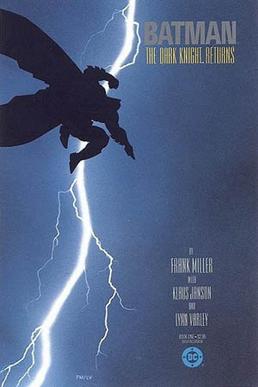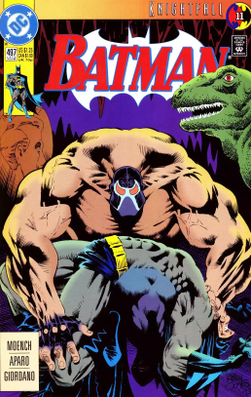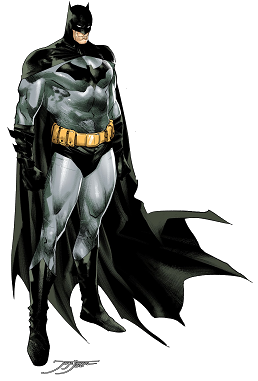
The Dark Knight Returns is a 1986 four-issue comic book miniseries starring Batman, written by Frank Miller, illustrated by Miller and Klaus Janson, with color by Lynn Varley, and published by DC Comics. It tells an alternative story of Bruce Wayne, who at 55 years old returns from retirement to fight crime while facing opposition from the Gotham City police force and the United States government. The story also features the return of classic foes Two-Face and the Joker, and culminates with a confrontation with Superman, who is now a pawn of the government.

The Batcave is a subterranean location appearing in American comic books published by DC Comics. It is the headquarters of the superhero Batman, whose secret identity is Bruce Wayne and his partners, consisting of caves beneath his personal residence, Wayne Manor.

Clayface is an alias used by several supervillains appearing in American comic books published by DC Comics. Most incarnations of the character possess clay-like bodies and shapeshifting abilities, and all of them are adversaries of the superhero Batman. In 2009, Clayface was ranked as IGN's 73rd-greatest comic book villain of all time.

Hugo Strange is a supervillain appearing in comic books published by DC Comics, commonly as an adversary of the superhero Batman. The character is one of Batman's first recurring villains, and was also one of the first to discover his secret identity. The character first appeared in Detective Comics #36.

The Mad Hatter is a supervillain appearing in comic books published by DC Comics, commonly as an adversary of the superhero Batman. He is modeled after the Hatter from Lewis Carroll's novel Alice's Adventures in Wonderland, a character often called the "Mad Hatter" in adaptations of Carroll. A scientist who invents and uses technological mind control devices to influence and manipulate the minds of his victims, the Mad Hatter is one of Batman's most enduring enemies and belongs to the collective of adversaries that make up Batman's rogues gallery.

The Batmobile is the fictional car driven by the superhero Batman. Housed in the Batcave, which it accesses through a hidden entrance, the Batmobile is both a heavily armored tactical assault vehicle and a personalized custom-built pursuit and capture vehicle that is used by Batman in his fight against crime. Using the latest civilian performance technology, coupled with prototype military-grade hardware—most of which was developed by Wayne Enterprises—Batman creates an imposing hybrid monster car to prowl the streets of Gotham City.

Lucius Fox is a character appearing in American comic books published by DC Comics, commonly in association with the superhero Bruce Wayne / Batman. He is Wayne's business manager at Wayne Enterprises who runs the business interests that supply his equipment needs as well as financing his operations, and is the father of Luke Fox / Batwing, Tiffany Fox / Batgirl, and Jace Fox / Batman.

Jason Peter Todd is a character appearing in American comic books published by DC Comics. First appearing in Batman #357 in March 1983, he was created to succeed Dick Grayson as Robin, Batman's partner and sidekick. Initially sharing a similar origin to Grayson, his character's origin was rewritten after the Crisis on Infinite Earths event. Subsequent portrayals commonly depict Todd as an orphaned street delinquent with a troubled past and a violent demeanor, whom Batman attempts to reform and mentor.

Batman is a superhero appearing in media published by DC Entertainment. The character was created by Bruce Timm and Paul Dini and first appeared in the pilot episode of the animated television series Batman Beyond (1999–2001) set in the DC Animated Universe, voiced by Will Friedle.

The Bat-Signal is a distress signal device appearing in American comic books published by DC Comics, as a means to summon the superhero, Batman. It is a specially modified searchlight with a stylized emblem of a bat affixed to the light, allowing it to project a large bat symbol onto cloudy night skies over Gotham City.

"Knightfall" is a 1993–1994 Batman story arc published by DC Comics. It consists of a trilogy of storylines that ran from 1993 to 1994, consisting of "Knightfall", "Knightquest", and "KnightsEnd".

Batman's utility belt is a feature of Batman's costume. Similar belts are used by the various Robins, Batgirl, and other members of the Bat-family.

Hush is a supervillain appearing in American comic books published by DC Comics. Created by Jeph Loeb and Jim Lee, the character first appeared in Batman #609 in January 2003 as part of the twelve-issue storyline Batman: Hush. Hush serves as a criminal foil to the superhero Batman and belongs to the collective of adversaries that make up his rogues gallery.

Caroline Keene "Carrie" Kelley is a superheroine from Frank Miller's graphic novels Batman: The Dark Knight Returns (1986) and its sequels Batman: The Dark Knight Strikes Again (2001–2002) and The Dark Knight III: The Master Race (2015–2017). She becomes the new Robin in The Dark Knight Returns when she saves Batman's life. Later in The Dark Knight Strikes Again, she adopts the identity Catgirl, and in The Dark Knight III: The Master Race, she adopts the identity Batwoman. She was the first full-time female Robin in the history of the Batman franchise, though Julie Madison had passed off as Robin for a brief time in a Bob Kane story published in Detective Comics #49 in March 1941.

The Batsuit is the costume of DC Comics's fictional superhero Batman, who appears in their American comic books. The suit has been depicted in various artistic iterations, and the stories themselves have described Batman as modifying the details of his costume from time to time. However, it usually consists of a gray or black body suit, the chest emblazoned with a stylized black bat either with or without a yellow ellipse around it, and blue-black accessories: a wide scalloped cape, gloves with a series of fin-like projections, black or blue trunks, boots, and a close-fitting cowl with ear-like projections to suggest a bat's head; and a yellow or gold utility belt containing a variety of gadgets.

The Batboat, Batstrike, or Batsub is the fictional personal aqua-dynamic hydrofoil/submersible watercraft of the DC Comics superhero Batman.

The Batplane, Batwing, Batjet or Batgyro is the fictional aircraft for the DC Comics superhero Batman. The vehicle was introduced in "Batman Versus The Vampire, I", published in Detective Comics #31 in 1939, a story which saw Batman travel to continental Europe. In this issue it was referred to as the "Batgyro", and according to Les Daniels was "apparently inspired by Igor Sikorsky's first successful helicopter flight" of the same year. Initially based upon either an autogyro or helicopter, with a rotor, the Batgyro featured a bat motif at the front. The writers gave the Batgyro the ability to be "parked" in the air by Batman, hovering in such a way as to maintain its position and allow Batman to return.

Batman is an arcade vehicular combat game based on the DC Comics character Batman, developed by Specular Interactive and released by Raw Thrills in 2013. The game can be single-player or multi-player.

Batman: Arkham VR is a virtual reality adventure video game developed by Rocksteady Studios and published by Warner Bros. Interactive Entertainment for PlayStation 4 and Windows. Based on the DC Comics superhero Batman, it is part of the Batman: Arkham series and the first installment to use virtual reality headsets, allowing players to experience the game world from Batman's perspective. Arkham VR was released worldwide on October 11, 2016, for PlayStation 4 and on April 25, 2017, for Windows for VR headsets.

The fictional supervillain Penguin, created by Bob Kane and Bill Finger, made his first appearance in Detective Comics #58. Since then, he has been adapted into other forms of media, including feature films, television series, and video games.




















